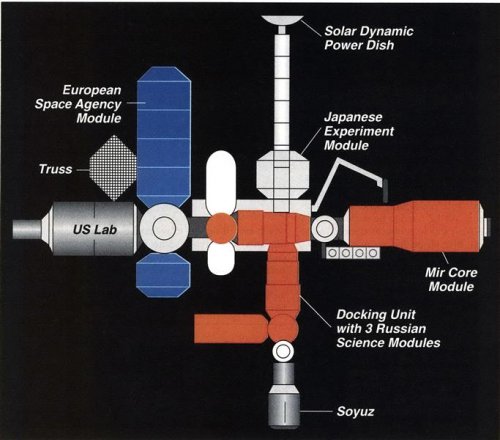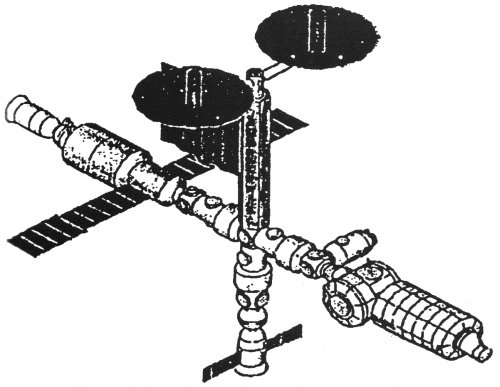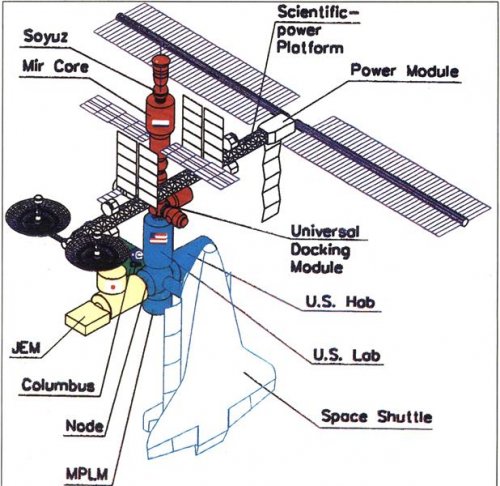Hello everyone. I am new to the forum and I want to ask if my fellow members would be willing to post any documents, diagrams, concept art, etc. they may possess describing proposed configurations of the ISS when it was called "Space Station Alpha" back in 1993-4. I am seeking material depicting designs that were being discussed when Russia first joined the project such as those that utilized dynamic solar power collectors or did not include the FGB control module, citing two examples. Many thanks in advance.
You are using an out of date browser. It may not display this or other websites correctly.
You should upgrade or use an alternative browser.
You should upgrade or use an alternative browser.
Space Station (R)alpha
- Joined
- 9 October 2009
- Messages
- 21,978
- Reaction score
- 13,638
Welcome to the forum Ninjaman! I'll have a poke around my files and sources later to see if I have anything you haven't come across already.
- Joined
- 9 October 2009
- Messages
- 21,978
- Reaction score
- 13,638
You probably already know about the original Russian proposal from even before they were part of the Alpha project (they formally came on board in September 1993) to use Mir-2 (in its scaled down Mir-1.5 second revision form [first revision still required Buran which was defunct by 1992]) as the basis of Alpha (Phase two in other words), with international modules being added around it (Phase Three), rather than just use components originally intended for Mir-2 to help build the station. I haven't been able to find any drawings or artwork yet of this exact Station Alpha proposal, but see below a quick overview of what that version of Mir-2 was originally intended to involve, via Astronautix.
Here's a image (linked over from our Mir-2 thread) of the pre-Alpha Mir-2 (Mir-1.5 second revision) as described above:

By 1992 Buran was now out of the picture and the plan was reduced in scale again. These revised plans were approved by the Council of Chief Designers on 24 November 1992. Mir-2 returned to its original planned 65 degree orbit, and would be assembled and flown separately from Mir. It would now consist of the DOS-8 core module, and a cross beam called the NEP (scientific-energy platform). This was equipped with equipment already proven on Mir: MSB retractable solar panels, Sfora thruster packages, small scientific packages as demonstrated on Kvant.
The add-on modules now used the Progress-M service module as a tug, and were reduced in size for launch by either the Soyuz or Zenit launch vehicles. Earth resources had been eliminated as a station activity (presumably Mir work had shown photographing the earth was more practical using free-flying satellites). Instead the four modules would weigh only 3 to 4 metric tons each and consist of:
A more capable resupply craft could be realized by using the Progress module with larger cargo or space station modules. The planned Progress-M2 11F615A75 was originally designed for use with the 90 metric ton module Mir-2. Redesigned in 1992-1993 for use with the more modest Mir-2 it had a revised index number of 11F615A77. The 13.3 metric ton, 12.6 m long vehicle consisted of the 5.3 metric ton service module, a 2.3 metric ton pressurized forward module equipped with a docking port, and could hold 5.7 metric tons of cargo. It could also be outfitted as a laboratory and left docked with the Mir-2.
- Docking Module - with the APDS universal androgynous docking system, and a side hatch for space walks
- Resource Module - Equipped with gyrodynes for orienting the station and a passive docking port for docking of Soyuz or Progress ferry spacecraft
- Technology Module - with materials experiments
- Biotechnology Module
Here's a image (linked over from our Mir-2 thread) of the pre-Alpha Mir-2 (Mir-1.5 second revision) as described above:
Last edited:
- Joined
- 9 October 2009
- Messages
- 21,978
- Reaction score
- 13,638
On a side note, there seems to have been actually a version of the Mir-1.5 proposal with the Earth Surveillance Module (MDZZ) inherited from the late '80s version of the Mir-2 project, but it appears to have been dropped very quickly in favour of the revision one design. Link to an old 3D modeller's site.
Last edited:
- Joined
- 9 October 2009
- Messages
- 21,978
- Reaction score
- 13,638
Here's a diagram of that early Russian proposal courtesy of AW&ST's online archive:
I overlooked that one, probably thought it was behind a paywall.
Nice find! So 'Mir-1.5' was first conceived with a DOS-7 core instead of the DOS-8. (I might have actually heard that somewhere before but forgotten it.There are some outstanding articles on the Russian program found at the Belgian chapter of the BIS website written by it's executive director, Bart Hendrickx. Below is quite a comprehensive history of the Mir2-Alpha-Ralpha period
Have you seen this for some general hardware background?: https://en.wikisource.org/wiki/Mir_Hardware_Heritage/Part_3_-_Space_Station_Modules
Last edited:
Yep- I found that one at NTRS (Mr. Portree is a great resource!). As for the AW&ST archive, the articles are not available in a legible format without subscribing but the accompanying illustrations can be had via the search engine.Here's a diagram of that early Russian proposal courtesy of AW&ST's online archive:
I overlooked that one, probably thought it was behind a paywall.
jThere are some outstanding articles on the Russian program found at the Belgian chapter of the BIS website written by it's executive director, Bart Hendrickx. Below is quite a comprehensive history of the Mir2-Alpha-Ralpha period
Nice find! So 'Mir-1.5' was first conceived with a DOS-7 core instead of the DOS-8. (I might have actually heard that somewhere before but forgotten it.) And the Russians at least originally considered the second revision to be a separate plan from 'Mir-1.5'. Interesting.
Have you seen this for some general hardware background?: https://en.wikisource.org/wiki/Mir_Hardware_Heritage/Part_3_-_Space_Station_Modules
Speaking of great resources, here's another piece by Mr. Hendricksx recounting Mir hardware history (The file is too large to attach):
Last edited:
- Joined
- 9 October 2009
- Messages
- 21,978
- Reaction score
- 13,638
Very nice indeed, thanks.
Similar threads
-
-
International Lunar Research Station (Sino-Russian project)
- Started by Grey Havoc
- Replies: 21
-
-
Russia To Send Asteroid Apophis Back into Deep Black Space
- Started by Triton
- Replies: 16
-
Russian-American Observation Satellite (RAMOS)
- Started by Grey Havoc
- Replies: 0



